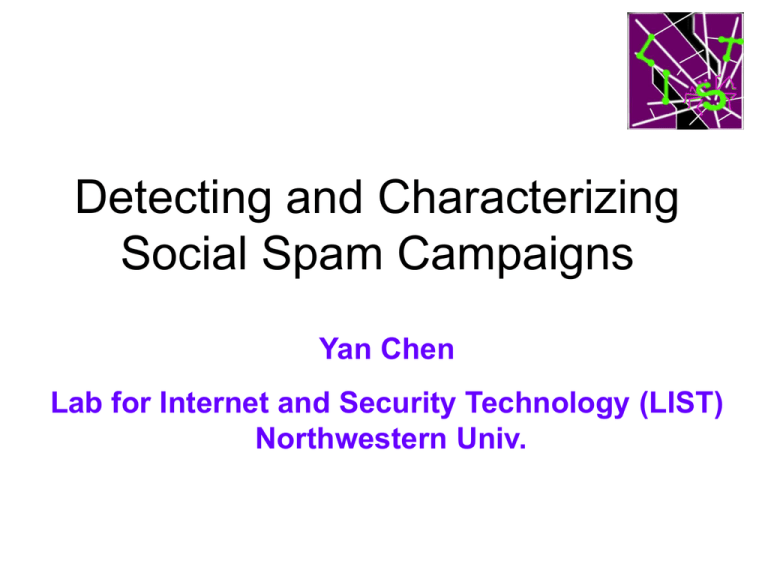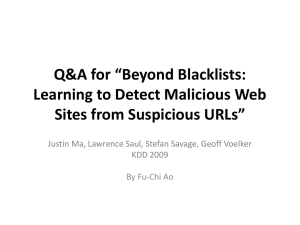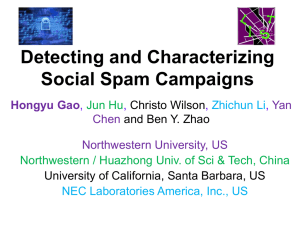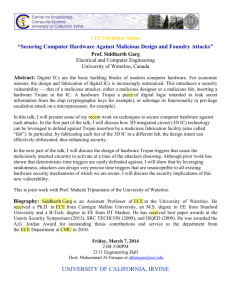scavenger
advertisement

Detecting and Characterizing Social Spam Campaigns Yan Chen Lab for Internet and Security Technology (LIST) Northwestern Univ. Detecting and Characterizing Social Spam Campaigns: Roadmap • • • • • Motivation & Goal Detection System Design Experimental Validation Malicious Activity Analysis Conclusions 2 Detecting and Characterizing Social Spam Campaigns: Roadmap • • • • • Motivation & Goal Detection System Design Experimental Validation Malicious Activity Analysis Conclusions 3 Motivation • Online social networks (OSNs) are exceptionally useful collaboration and communication tools for millions of Internet users. – 400M active users for Facebook alone – Facebook surpassed Google as the most visited website 4 Motivation • Unfortunately, the trusted communities in OSN could become highly effective mechanisms for spreading miscreant activities. – Popular OSNs have recently become the target of phishing attacks – account credentials are already being sold online in underground forums 5 Goal • In this study, our goal is to: – Design a systematic approach that can effectively detect the miscreant activities in the wild in popular OSNs. – Quantitatively analyze and characterize the verified detection result to provide further understanding on these attacks. 6 Detecting and Characterizing Social Spam Campaigns: Roadmap • • • • • Motivation & Goal Detection System Design Experimental Validation Malicious Activity Analysis Conclusions 7 Detection System Design The system design, starting from raw data collection and ending with accurate classification of malicious wall posts and corresponding users. 8 Data Collection • Based on “wall” messages crawled from Facebook (crawling period: Apr. 09 ~ Jun. 09 and Sept. 09). • Leveraging unauthenticated regional networks, we recorded the crawled users’ profile, friend list, and interaction records going back to January 1, 2008. • 187M wall posts with 3.5M recipients are used in this study. 9 Filter posts without URLs • Assumption: All spam posts should contain some form of URL, since the attacker wants the recipient to go to some destination on the web. • Example (without URL): Kevin! Lol u look so good tonight!!! Filter out 10 Filter posts without URLs • Assumption: All spam posts should contain some form of URL, since the attacker wants the recipient to go to some destination on the web. • Example (with URL): Um maybe also this: http://community.livejournal.com/lemonadepoem/54654.html Guess who your secret admirer is?? Go here nevasubevd\t. blogs pot\t.\tco\tm (take out spaces) Further process 11 Build Post Similarity Graph • After filtering wall posts without URLs, we build the post similarity graph on the remaining ones. – A node: a remaining wall post – An edge: if the two wall posts are “similar” and are thus likely to be generated from the same spam campaign 12 Wall Post Similarity Metric • Two wall posts are “similar” if: – They share similar descriptions, or – They share the same URL. • Example (similar descriptions): Guess who your secret admirer is?? Go here nevasubevd\t. blogs pot\t.\tco\tm (take out spaces) Guess who your secret admirer is?? Visit: \tyes-crush\t.\tcom\t (remove\tspaces) Establish an edge! 13 Wall Post Similarity Metric • Two wall posts are “similar” if: – They share similar descriptions, or – They share the same URL. • Example (same URL): secret admirer revealed. goto yourlovecalc\t.\tcom (remove the spaces) hey see your love compatibility ! go here yourlovecalc\t.\tcom (remove\tspaces) Establish an edge! 14 Extract Wall Post Clusters • Intuition: – If A and B are generated from the same spam campaign while B and C are generated from the same spam campaign, then A, B and C are all generated from the same spam campaign. • We reduce the problem of extract wall post clusters to identifying connected subgraphs inside the post similarity graph. 15 Extract Wall Post Clusters A sample wall post similarity graph and the corresponding clustering process (for illustrative purpose only) 16 Identify Malicious Clusters • The following heuristics are used to distinguish malicious clusters (spam campaigns) from benign ones: – Distributed property: the cluster is posted by at least n distinct users. – Bursty property: the median interval of two consecutive wall posts is less than t. 17 Identify Malicious Clusters Maliciousfrom_user >= n && interval <= t? Cluster!! Yes!! from_user >= n && interval <= t? NO!! from_userBenign >= n && interval <= t? Cluster!! NO!! Benign Cluster!! from_user >= n && >= interval <= t? from_user n from_user >= n && interval <=NO!! t? && intervalBenign <= t? NO!! NO!! Cluster!! Benign Benign Cluster!! Cluster!! from_user >= n && interval <= t? Yes!! Malicious Cluster!! from_user >= n && interval <= t? Yes!! Malicious Cluster!! A sample process of distinguishing malicious clusters from benign ones (for illustrative purpose only) 18 Identify Malicious Clusters • (6, 3hr) is found to be a good (n, t) value by testing TF:FP rates on the border line. • Slightly modifying the value only have minor impact on the detection result. • Sensitivity test: we vary the threshold – (6, 3 hr) to (4, 6hr) – Only result in 4% increase in the classified malicious cluster. 19 Detecting and Characterizing Social Spam Campaigns: Roadmap • • • • • Motivation & Goal Detection System Design Experimental Validation Malicious Activity Analysis Conclusions 20 Experimental Validation • The validation is focused on detected URLs. • A rigid set of approaches are adopted to confirm the malice of the detection result. • The URL that cannot be confirmed by any approach will be assumed as “benign” (false positive). 21 Experimental Validation • Step 1: Obfuscated URL – URLs embedded with obfuscation are malicious, since there is no incentive for benign users to do so. – Detecting obfuscated URLs, e.g., • Replacing ‘.’ with “dot”, e.g., 1lovecrush dot com • Inserting white spaces, e.g., abbykywyty\t. blogs pot\t.\tco\tm, etc. • Have a complete such list from anti-spam research 22 Experimental Validation • Step 2: Third-party tools – Multiple tools are used, including: • McAfee SiteAdvisor • Google’s Safe Browsing API • URL blacklist (SURBL, URIBL, Spamhaus, SquidGuard) • Wepawet, drive-by-download checking – The URL that is classified as “malicious” by at least one of these tools will be confirmed as malicious 23 Experimental Validation • Step 3: Redirection analysis – Any URL that redirects to a confirmed malicious URL is considered as “malicious”, too. • Step 4: Wall post keyword search – If the wall post contains typical spam keyword, like “viagra”, “enlarger pill”, “legal bud”, etc, the contained URL is considered as “malicious”. – Human assistance is involved to acquire such keywords 24 Experimental Validation • Step 5: URL grouping – Groups of URLs exhibit highly uniform features. Some have been confirmed as “malicious” previously. The rest are also considered as “malicious”. – Human assistance is involved in identifying such groups. • Step 6: Manual analysis – We leverage Google search engine to confirm the malice of URLs that appear many times in our trace. 25 Experimental Validation The validation result. Each row gives the number of confirmed URL and wall posts in a given step. The total # of wall posts after filtering is ~2M out of 187M. 26 Detecting and Characterizing Social Spam Campaigns: Roadmap • • • • • Motivation & Goal Detection System Design Experimental Validation Malicious Activity Analysis Conclusions 27 Usage summary of 3 URL Formats • 3 different URL formats (with e.g.): – Link: <a href=“...”>http://2url.org/?67592</a> – Plain text: mynewcrsh.com – Obfuscated: nevasubevu\t. blogs pot\t.\tco\tm 28 Usage summary of 4 Domain Types • 4 different domain types (with e.g.): – – – – Content sharing service: imageshack.us URL shortening service: tinyurl.org Blog service: blogspot.com Other: yes-crush.com 29 Spam Campaign Identification 30 Spam Campaign Temporal Correlation 31 Attack Categorization • The attacks categorized by purpose. • Narcotics, pharma and luxury stands for the corresponding product selling. 32 User Interaction Degree • Malicious accounts exhibit higher interaction degree than benign ones. 33 User Active Time • Active time is measured as the time between the first and last observed wall post made by the user. • Malicious accounts exhibit much shorter active time comparing to benign ones. 34 Wall Post Hourly Distribution • The hourly distribution of benign posts is consistent with the diurnal pattern of human, while that of malicious posts is not. 35 Detecting and Characterizing Social Spam Campaigns: Roadmap • • • • • Motivation & Goal Detection System Design Experimental Validation Malicious Activity Analysis Conclusions 36 Conclusions • We design our automated techniques to detect coordinated spam campaigns on Facebook. • Based on the detection result, we conduct indepth analysis on the malicious activities and make interesting discoveries, including: – Over 70% of attacks are phishing attacks. – malicious posts do not exhibit human diurnal patterns. – etc. 37 Thank you! 38 Extract Wall Post Clusters The algorithm for wall post clustering. The detail of breadth-first search (BFS) is omitted. 39





